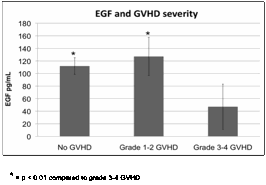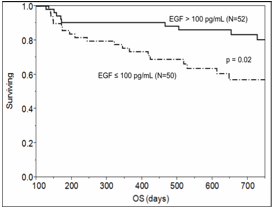Background: Hypomagnesemia is a frequent complication of allogeneic hematopoietic cell transplantation (HCT) and is related to cyclosporine-induced renal magnesium (Mg) loss. The importance of epidermal growth factor (EGF) in renal Mg reabsorption was suggested after identification of EGF mutation in isolated autosomal recessive hypomagnesemia (IRH). Mg wasting is also associated with EGFR tyrosine kinase inhibitors used in oncologic treatment. Recently, a link between EGF, Mg, and cyclosporine (CSA) in renal transplant recipients has been proposed through downregulation of EGF leading to inhibition of the Mg channel TRMP6 in the distal convoluted tubule, but similar associations have not been investigated post-allogeneic HCT. We hypothesized that lower serum EGF would be associated with higher CSA levels, acute graft versus host disease (GVHD) status, and more severe Mg wasting after allogeneic HCT.
Patients and Methods: 107 adult allogeneic HCT recipients from the University of Minnesota enrolled on an immune monitoring study had EGF levels measured by magnetic bead array at day +100 post-allogeneic HCT. Clinical variables collected for analysis included patient age, sex, underlying diagnosis, donor type, HCT conditioning regimen, maximum acute GVHD overall grade and organ involvement prior to day +100, use of oral and intravenous supplemental Mg including cumulative requirements over 2 weeks, and concurrent immunosuppressive drug therapy including cyclosporine (N=66), tacrolimus (N=13), mycophenolate mofetil (N=5), sirolimus (N=22), and prednisone (N=40). Lab variables analyzed included serum creatinine and estimated glomerular filtration rate (GFR), immune suppressive drug levels, Mg levels, and lymphocyte subsets including absolute counts and percentages of NK cells, B cells, CD4+ T cells, CD8+ T cells, and regulatory T cells.
Results: 54 patients had acute GVHD (grade I-II n= 34, grade III-IV n =20) and 53 patients did not have acute GVHD prior to the day +100 serum sample collection. The median serum EGF in this cohort was 101 pg/mL (not detectable in 5 samples). Levels of EGF at day +100 showed no relationship with age, underlying diagnosis, donor type, or conditioning intensity. EGF was significantly lower in patients who had acute GVHD grade III-IV prior to day +100 (Figure 1) and nearly 3-fold lower in those with upper GI GVHD involvement versus no upper GI GVHD involvement (median 43 pg/mL versus 119 pg/ml, p=0.007). Serum EGF negatively correlated with CSA level (Spearman's rho = -0.34, p=0.007), but not with tacrolimus levels, sirolimus levels, prednisone dose, or serum creatinine. Mg requirements, measured as either daily dose or cumulative dose over 2 weeks prior to the EGF sampling, were not associated with serum EGF overall, but those with EGF > 100 pg/mL showed higher magnesium requirements (average daily dose (1060 ± 142 mg/day versus 600 ± 85 mg mg/day, p=0.02) and average cumulative dose over 2 weeks (14.6 ± 2 grams versus 9 ± 1.3 grams, p=0.04) prior to the blood draw. Patients with or without acute GVHD required similar Mg supplementation. EGF levels showed a modest correlation with overall lymphocyte percentage in the peripheral blood (Spearman's rho = 0.24, p=0.01), but not with specific lymphocyte subsets at day +100. Serum EGF levels > 100 pg/mL at day +100 were associated with improved 2-year survival (RR 0.46, 95% CI 0.22–0.94, p=0.03, Figure 2).
Conclusions: Patients with prior grade III-IV acute GVHD, and in particular upper GI GVHD, had lower EGF levels at day +100. This may be due in part to decreased EGF production from Brunner's glands in the duodenum versus excess EGF losses. The inverse relationship between CSA and EGF may be direct or may represent patients with more severe acute GVHD being maintained with higher drug levels. Serum EGF was negatively correlated with CSA levels but not Mg requirements or serum creatinine/estimated GFR. While studies in renal transplantation identified a connection between urinary EGF, Mg wasting, and diminished renal function, circulating levels of EGF in allogeneic HCT did not show a similar correlation. Differences in EGF post-allogeneic HCT are predominantly due to grade III-IV GVHD status, although a potential contribution from CSA effect on the kidney cannot be ruled out. The role of circulating EGF in the long-term outcomes of allogeneic HCT should be further studied.
No relevant conflicts of interest to declare.
Author notes
Asterisk with author names denotes non-ASH members.



This feature is available to Subscribers Only
Sign In or Create an Account Close Modal